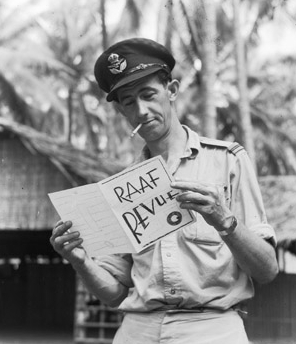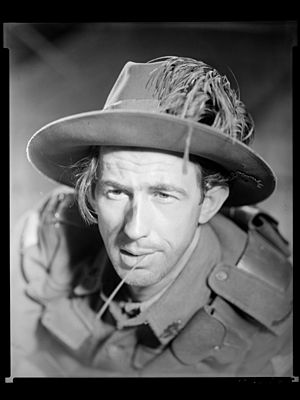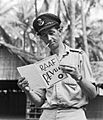Chips Rafferty facts for kids
Quick facts for kids
Chips Rafferty
|
|
|---|---|

Rafferty in 1943
|
|
| Born |
John William Pilbean Goffage
26 March 1909 Broken Hill, New South Wales, Australia
|
| Died | 27 May 1971 (aged 62) Sydney, New South Wales, Australia
|
| Resting place | Ashes cast into his favourite fishing hole in Lovett Bay, Pittwater |
| Occupation | Actor |
| Years active | 1939–1971 |
| Spouse(s) | Ellen Jameson (1941–1964; her death) |
John William Pilbean Goffage (born March 26, 1909 – died May 27, 1971) was an Australian actor. He was known by his stage name, Chips Rafferty. Many people saw him as the perfect example of a typical Australian.
Chips Rafferty's acting career lasted from the late 1930s until he passed away in 1971. He appeared in many big Australian movies. He also acted in films made in Britain and America. Some of his famous movies include The Overlanders and The Sundowners. In the late 1950s, he even appeared in TV ads in Britain. These ads encouraged British people to move to Australia.
Contents
Chips Rafferty's Early Life
John William Pilbean Goffage was born in Broken Hill, New South Wales, Australia. His father, John Goffage, was from England. His mother, Violet Maude Joyce, was Australian. Chips got his nickname "Chips" when he was a schoolboy.
He went to Parramatta Commercial School. After school, he worked many different jobs. He was an opal miner, a sheep shearer, and a drover (someone who moves livestock). He also worked as an officer in the RAAF and as a pearl diver.
Chips Rafferty's Film Career Begins
Chips Rafferty first appeared in a movie in 1938. It was a comedy called Ants in His Pants. He was an extra in the film, meaning he was part of the crowd. At that time, he managed a wine cellar in Sydney.
He really enjoyed acting. So, he got another small role in a movie called Dad Rudd, M.P. (1940). In this film, he played one of several clumsy firefighters.
Becoming Famous with Forty Thousand Horsemen
Chips Rafferty became famous around the world with the movie Forty Thousand Horsemen (1940). He was one of the three main actors. The film was directed by Charles Chauvel. It told the story of the Battle of Beersheba in 1917.
Charles Chauvel chose Rafferty after a screen test. Chauvel said he was like a mix of two famous actors, Slim Summerville and James Stewart. He also said Rafferty had a funny and natural sense of humor. Chips played a tall, quiet bushman in the movie.
Forty Thousand Horsemen was very popular. It was shown all over the world. It became one of the most-watched Australian films of its time. Even though other actors played the romantic leads, Chips Rafferty's acting was highly praised.
Serving in the War
Chips Rafferty married Ellen Kathleen "Quentin" Jameson on May 28, 1941. The very next day, he joined the Royal Australian Air Force. During his time in the RAAF, he helped entertain the troops.
While serving, Rafferty was allowed to make movies during his leave. He appeared in a short film called South West Pacific (1943). He also worked again with director Charles Chauvel and actor Grant Taylor. They made The Rats of Tobruk (1944). This movie tried to be as successful as Forty Thousand Horsemen.
Chips Rafferty left the RAAF on February 13, 1945. He had reached the rank of Flying Officer.
Gaining International Fame
After the war, a British film company called Ealing Studios wanted to make movies in Australia. They sent Harry Watt to find a good story. He found The Overlanders (1946). This movie was about a cattle drive during wartime, based on a true story. Harry Watt gave the main role to Chips Rafferty. Watt called him an "Australian Gary Cooper."
Rafferty was paid £25 a week for the film. Ealing Studios was very happy with his work. They signed him to a long-term contract even before the movie was released. The Overlanders was a big success with critics and audiences. This made Chips Rafferty a film star.
Ealing Studios worked with Rank Films. Rank Films cast Rafferty in the main role of Bush Christmas (1947). This was a children's movie where Rafferty played the bad guy. It was very popular.
Ealing Studios then sent Rafferty to England to promote The Overlanders. While there, he acted in another film called The Loves of Joanna Godden. He also promoted the film in Hollywood. A famous writer, Hedda Hopper, said Rafferty caused a lot of excitement. She said he was "as natural as an old shoe."
Ealing and Harry Watt wanted to make another movie in Australia. They chose a big historical film, Eureka Stockade. Rafferty played Peter Lalor, the leader of a famous rebellion. However, the movie did not do well at the box office. Many people also criticized Rafferty's acting in it.
After this, Ealing put Rafferty in a drama about Aboriginal land rights. It was called Bitter Springs (1950). This film was not very popular. After this, Ealing Studios stopped making movies in Australia.
Chips Rafferty continued to be a busy actor. He appeared on radio in a show called Chips: Story of an Outback. He was also cast by 20th Century Fox in a drama filmed in Australia, Kangaroo (1952). The studio liked his acting so much that they flew him to Los Angeles. There, he played an Australian soldier in a war movie called The Desert Rats (1953).
Chips Rafferty Becomes a Producer
Making movies in Australia slowed down a lot. So, Chips Rafferty decided to start producing films himself. He wanted to make a movie called The Green Opal, about immigration. But he couldn't find the money.
Then, he teamed up with a director named Lee Robinson. They decided to make movies together. Their first movie was The Phantom Stockman (1953). Robinson directed it, and Rafferty starred in it. They both produced it. The movie made a profit.
Next, they made King of the Coral Sea, which was even more popular. This movie also introduced the actor Rod Taylor to audiences. Rafferty and Robinson then worked with French filmmakers. They made an adventure story set in New Guinea called Walk Into Paradise (1956). This became their most popular movie so far.
Chips Rafferty also acted in other films. He was in a British comedy filmed in Australia, Smiley (1956). It was successful and led to a sequel, Smiley Gets a Gun (1958). Rafferty played his role again in the sequel. In England, he appeared in The Flaming Sword (1958).
He also took part in TV ads for the Australian Government in 1957. This campaign was called "Bring out a Briton." It aimed to get more British people to move to Australia.
Rafferty and Robinson raised money for three more movies. However, Rafferty chose not to act in their fourth film, Dust in the Sun (1958). This movie was their first failure together. He also wasn't in The Stowaway (1959) or The Restless and the Damned (1960). All three of these films lost money. This caused Chips Rafferty to have money problems.
Later Acting Career
After his producing projects struggled, Chips Rafferty went back to being just an actor. He had a small role in The Sundowners (1960). This movie starred Robert Mitchum and Deborah Kerr. He also played a coastwatcher (someone who watches the coast for enemy ships) in The Wackiest Ship in the Army (1960). This film starred Jack Lemmon and Ricky Nelson. He also appeared in several episodes of the Australian TV series Whiplash (1961).
Rafferty was cast as one of the mutineers in the 1962 remake of Mutiny on the Bounty. This movie starred Marlon Brando. Filming Bounty in Tahiti took a long time, over six months. But it helped him get out of his money troubles. He earned enough to buy an apartment building, which supported him for the rest of his life. Rafferty joked that the film should be called The Bounteous Mutiny.
In 1963, he recorded a music album called A man and his horse. On the album, he narrated poems by famous Australian poets. These included Banjo Paterson and Adam Lindsay Gordon.
In 1964, he played the Australian Prime Minister in the sci-fi TV series The Stranger. Then he went to England. He appeared in eight episodes of Emergency-Ward 10 (1964). While in England, he was also in The Winds of Green Monday (1965) on British TV.
He then traveled to the United States. He guest-starred in episodes of The Wackiest Ship in the Army (1965). He played a different character than in the movie version. This led to more offers to work in Hollywood TV shows. He played a Union soldier in The Big Valley (1966). His Australian accent was very noticeable. He also appeared in episodes of Gunsmoke (1966) and Daktari (1966). In 1966, he said he had to look to America for his future. This was because there was not much support for actors from the Australian government.
Back in Australia, Rafferty had a good role in the comedy They're a Weird Mob (1966). This movie was a big success in Australia. He returned to Hollywood to appear in episodes of The Girl from UNCLE (1967) and Tarzan (1967). He was also in The Monkees TV show. He acted in the Elvis Presley movie Double Trouble (1967). And he was in the adventure film Kona Coast (1968).
Returning to Australia, he guest-starred in Skippy the Bush Kangaroo. He also appeared in Adventures of the Seaspray (1967), Rita and Wally (1968), Woobinda, Animal Doctor (1970), and Dead Men Running (1971). He continued to make films like Skullduggery (1970).
Chips Rafferty's last movie role was in Wake in Fright (1971). He played an outback policeman in this film. The movie was mostly filmed near his hometown of Broken Hill. A critic praised his acting in the movie. They said he gave a powerful and memorable performance.
His very last acting job was in an episode of the Australian war series Spyforce (1971). Hours before he died, he was offered a big role in a film by Jerry Lewis. However, that movie was never finished.
Chips Rafferty's Death
On May 27, 1971, Chips Rafferty collapsed and died. He had a heart attack at age 62. This happened while he was walking down a street in Sydney. He had just finished filming his role in Wake in Fright. His wife, Quentin, had passed away in 1964. They did not have any children. His body was cremated. His ashes were scattered into his favorite fishing spot in Lovett Bay.
Honours and Recognition
In 1971, Queen Elizabeth II made Chips Rafferty a Member of the Order of the British Empire (MBE). This was to recognize his great work in the performing arts.
Australia Post released a stamp in 1989 that showed Rafferty. This honored his contributions to Australian cinema. In March 2006, the Broken Hill City Council named the town's Entertainment Centre after him.
The Oxford Companion to Australian Film called Rafferty "Australia's most prominent and significant actor of the 1940s–60s."
Australian singer/songwriter Richard Davies wrote a song about him. It's called "Chips Rafferty" and is on his album, There's Never Been A Crowd Like This.
Other Interests and Associations
Chips Rafferty was also a talented artist. He was known as "Long John Goffage" in the Black and White Artists' Club. He was also a Freemason.
Filmography
| Year | Title | Role | Notes |
|---|---|---|---|
| 1939 | Come Up Smiling | Man in Crowd | Also known as Ants in His Pants, Uncredited |
| 1940 | Dad Rudd, MP | Fireman | |
| Forty Thousand Horsemen | Jim | ||
| 1944 | The Rats of Tobruk | Milo Trent | |
| 1946 | The Overlanders | Dan McAlpine | |
| 1947 | Bush Christmas | Long Bill | |
| The Loves of Joanna Godden | Collard | Filmed in Britain. | |
| 1949 | Eureka Stockade | Peter Lalor | Released as Massacre Hill in the United States. |
| 1950 | Bitter Springs | Wally King | |
| 1952 | Kangaroo | Trooper 'Len' Leonard | Rafferty's first Hollywood-financed film, though shot in Australia. |
| 1953 | The Desert Rats | Sgt. 'Blue' Smith | Filmed in Hollywood. |
| The Phantom Stockman | The Sundowner | Rafferty also produced and helped write the script. Released in the United States as Return of the Plainsman. | |
| King of the Coral Sea | Ted King | Rafferty also produced and helped write the script. | |
| 1956 | Smiley | Sergeant Flaxman | |
| Walk Into Paradise | Steve MacAllister | Rafferty also produced. Released in the United States as Walk into Hell | |
| 1958 | Smiley Gets a Gun | Sergeant Flaxman | |
| The Flaming Sword | Long Tom | ||
| 1960 | The Sundowners | Quinlan | |
| The Wackiest Ship in the Army | Patterson | A comedy, with Rafferty as an Australian Coastwatcher on a secret mission, and Jack Lemmon in charge of the ship | |
| 1962 | Mutiny on the Bounty | Michael Byrne | Rafferty was in financial difficulty after the failure of some of his producing projects, but he got out of it with all the overtime he earned during the production of this film. |
| Alice in Wonderland | White Knight | Televised pantomime | |
| 1964 | The Stranger | The Australian Prime Minister | Episode 12 |
| 1966 | They're a Weird Mob | Harry Kelly | |
| 1967 | Adventures of the Seaspray | ||
| Double Trouble | Archie Brown | Filmed in Britain. | |
| 1968 | Kona Coast | Charlie Lightfoot | |
| 1970 | Skullduggery | Father 'Pop' Dillingham | |
| 1971 | Dead Men Running | ||
| Wake in Fright | Jock Crawford | ||
| Spyforce | Leon Rielley | Episode: Reilley's Army, (final appearance) |
Images for kids



